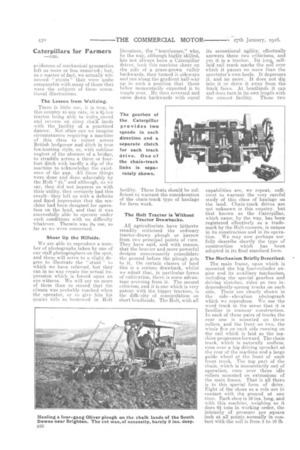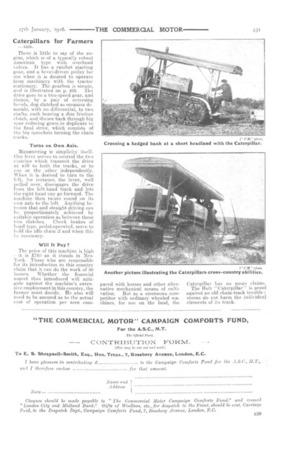Caterpillars for Farmers.
Page 5

Page 6

Page 7

If you've noticed an error in this article please click here to report it so we can fix it.
An Account of a Series of Tests Carried Out on a Farm near Brighton with a Holt Caterpillar Tractor Hauling an Oliver Four-gang Plough.
Evidence is rapidly accumulating that the economic conditions in this country will eventually force the hand or the farmer, and he will be compelled to refrain from withholding any longer careful consideration of the possibilities of further substitution of mechanical means for animal haulage.
motors of various kinds have, as a ride, conic away from such tests with the impression that designers and manufacturers are at present rather inclined to rely upon the improvisation of machines which are initially constructed for baidage on the road to operate on the land in its crude state. Only in a few cases have the producers of machines intended for agricultural haulage set to work to produce something which shall in the first place be suitable for operation on the land, whilst their adaptability as ordinary road-haulage implements has been a secondary consideration. We write particularly of those British and American machines which have demonstrated to some effect in this country already. We are aware that more advanced ideas, in the direction we have indicated, are the property of many French agriculturists and machinists.
Part and Parcel of the Farm.
We have now had the opportunity to watch the evolutions of one of the Holt Caterpillar tractors, which have achieved the distinction of very extensive service in most of the armies of the nations combatant at the present time, and, as we write, we are left with the impression that here is a machine that is part and parcel of the farm and its lands. To see the Holt Caterpillar come across country, disregarding hedges, ditches, piles of stones, roadside embankments, and other countryside obstacles, and make straight for the greasy grassgrown slope of a steep hill, was to convince one that many of the very remarkable claims made on behalf of this machine by its American producers are easily substantiated. Here, indeed, is a machine, de signed for use on the land, and able ..„ to be employed •on the road. Hitherto, with a few noteworthy exceptions, we have been asked to consider the suitability of tractors primarily designed to run on made tracks, and suggested as adaptable for employment on the land. That is the basic difference between the chain-track idea and the ordinary wheeled tractor.
On Thursday last, at a farm up on the South Downs, six miles or so from Brighton, we saw the Holt caterpillar "45." as it is called, as much a part of the equipment Of Mr. Fel's farm as were the ploughs and threshers and other tackle to which we are all so accustomed.
Mechanical Gymnastics. .
We have come to look somewhat askance. at the ordinary American. born " stunt." We are accustomed to carefully. stage-managed effects, showing machines of all kinds performing feats of little utility, but certainly sensational. On our way to the tests, Mr. V. F. Feeny, who represents • Caterpillar Tractors, Ltd., of which the businessaddress is .60, Queen Victoria Street, E.C., had, as he playfully put it, " doped " us with such cleverly-contrived. literature, which was, as is the custom, plentifully illustrated with pictures of Holt Caterpillars deing everything possible in the way of haulage, from pulling endless rows of trailers, loaded with pine logs, on frozen Yukon river's, to hauling Austrian heavy howitzers, hub-cap deep in mire, that we were feign to confess that until we reached Brighton these pictorial
evidences of mechanical gymnastics left us more or less unmoved ; but, as a matter of fact, we actually witnessed " stunts" that were quite comparable with many of those that were the subjects of these sensational illustrations.
The Lesson from Waltzing.
There is little use, it is true, in this country at any rate, in a 6iLon tractor being able to waltz...round and reverse on slimy chalk lands with the facility of a practised dancer. Not often can we imagine circumstances requiring a machine of this class to eareer across British hedgerow and ditch in true fox-hunting style, or, with sublime neglect of the absence of a bridge, to straddle across a three or fourfoot ditch with hardly a dip of the machine to acknowledge the existence of the gap. All these things were done and done admirably by the Holt "45," and although, as we say, they did not impress us with their utility, they certainly had this result—they left us with a definite and fixed impression that the machine had been designed for operation on the land, and that it was successfully able to operate under such conditions with no difficulty whatever. Therein was its use, so far as we were concerned.
Sheer Up the Hillside.
We are able to reproduce a number of photographs taken by one of our staff photographers on the spot., and these will serve to a slight degree to illustrate the " stunt" to which we have referred, but they can in no way create the actual impression which is forced upon an eye-witness. We will say no more of them than to record that the climax was probably reached when the operator, or to give him his quaint title as bestowed in Holt
literature, the "tractioneer," who, by the way, although highly skilled, has not always been a Caterpillar driver, took this machine sheer up the side of a grass-grown valley backwards, then turned it sideways and ran along the gradient half-way up in such a position that those below momentarily expected it to topple over. He then reversed and came down backwards with equal
facility. These feats should be sufficient to warrant the consideration of the chain-track type of haulage for farm work.
The Holt Tractor is 'Without Tractor Drawbacks.
All agriculturists have hitherto steadily criticised the ordinary tractor-drawn plough or harrow from two principal points of view. They have said, and with reason, that the heavier and more powerful designs unnecessarily consolidate the ground before the plough gets to it. On certain classes of land this is a serious drawback, whilst we admit that, in particular forms of cultivation, there.is some advantage accruing from it. The second criticism, and it is one which is very patent with the bigger tractors, is the diffinilty of manipulation on short headlands. The Holt, with all its sensational agility, effectually answers these two criticisms, and yet it is a tractor. Its long, selflaid rail track marks the soil over which it passes no more than the spectator's own heels. It depresses it, and no more.. It does not dig into it or drive it away from the track faces. At headlands it can and does turn in its own length with
the utmost facility. Those two capabilities are, we repeat, sufficient to warrant the very careful study of this class of haulage on the land. Chain-track drives are not unknown in this country, but that known as the Caterpillar, which name, by the way, has been registered effectively as a trade.. mark by the Holt concern, is unique in its construction and in its operation. We may now perhaps usefully describe shortly the type of construction which has been adopted in its final standard form.
The Mechanism Briefly Described
The main frame, upon which is mounted the big four-cylinder engine and its auxiliary mechanism, including the special gearbox and driving clutches, rides on two independently-sprung trucks on each side. These are clearly shown in the side elevation photograph which we reproduce. We use the word truck in the sense that it is familiar in tranica,r construction. In each of these uairs of trucks the rear one is mounted on three rollers, and the front on two, the whole five on each side running on the rail which is laid as the machine progresses forward. The chain track, which is naturally endless, runs over a big driving sprocket at the roar of the machine and a large guide wheel at the front of each front truck. The top part of the chain,, which is momentarily out of operation, runs over three idle rollers mounted on extensions of the main frame. That is all there is in this special form of drive. Eight of the shoes as a rule are in contact with the ground at one time. Each shoe is 10 ins, long, and with this machine, weighing as it does si tons in working order, the intensity of pressure per square inch at all points normally in eontact with the soil is from 5 to 10 lb. There is little to say of the engine, which is of a typically robust. American type with overhead valves. It has a ratchet starting gear, and a bevel-driven pulley for use when it is desired to operate farm machinery with the tractor stationary. The .gearbox is simple,
and is illustrated on p. 430. The drive goes to a two-speed gear, and thence, by a pair of reversing bevels, dog-clutched as occasion dc. niands, with no differential, to two shafts, each hearing a disc friction clutch, and thence back through big spur reducing gears in duplicate to the final drive, which consists of the his sprockets turning the chain tracks.
Turns on Own Axis.
Manceuvring is simplicity itself. One lever servos to control the two clutches which transmit the drive at will to both the tracks, or to one or the other independently. When it is desired to turn to the left, for instance, the lever, well pulled over, disengages the drive from the left-hand track and lets the right-hand one go forward. The machine then twists round on its own axis to the left. Anything between that and straight driving can be proportionately achieved by suitable operation as between these two clutches. Check brakes of band type, pedal-operated, serve to the idle chain if and when this he necessary.
Will It Pay ?
The price of this machine is high ---it is 750 as it stands in New York. Those who are responsible for its introduction to this country claim that it can do the work of :30 horses. Whether the financial aspect thus introduced will mitigate against the machine's extensive employment in this country, the farmer must decide. He also will need to be assured as to the actual cost of operation per acre corn




















